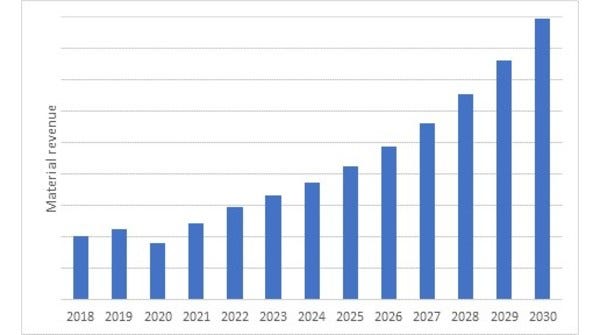3D Printing Materials Market to Reach $18 Billion in 2030
IDTechEx research shows the growth in 3D printing materials will reach nearly $20 billion by the end of the decade.
April 26, 2021

The market for 3D printing materials has been affected by the COVID-19 pandemic, yet plenty of market drivers point to a strong future, according to research from IDTechEx. In the report, 3D Printed Materials Market 2020-2030 - COVID Edition, the company forecasts that the global market for 3D printing materials will be worth $18.4 billion by 2030.

The last decade has seen an explosion in 3D printing among both hobbyists and professional users. 3D printing for prototypes is a long-standing practice. What’s new is the increasing ability to manufacture goods. Even small companies with just a CAD package and a 3D printer can become a manufacturer. Early in the pandemic, small local companies rushed to help fill the gap in medical PPE.
Although there are drawbacks to the 3D printing process, including proportionate cost and scalability, recent improvements in the technology’s capabilities resulted in pre-pandemic commentators predicting a bright future. The sector had been on a solid upward trajectory for a decade. Then came the pandemic.
The Impact of COVID-19
COVID-19 wrought havoc with many sectors, including automotive and aerospace, the traditional core markets for 3D printing. 3D printing experienced a strange ride during the pandemic. The FDA stated that “Non-traditional manufacturers and community responders have helped address shortages and gaps in medical supplies during COVID-19. That yielded millions of pieces of PPE (such as masks and face shields) and other 3D-printed medical accessories.”
While the entrepreneurial exuberance of 3D printing companies was impressive during the pandemic, the technology’s traditional market suffered. “The 3D printing sector generally, and materials in particular, have been affected by the COVID-19 pandemic,” Jonathan Harrop, director of IDTechEx, told Design News. “While the metal components market is still worth billions, two of the sectors most eager to incorporate printed components – aerospace and automotive – have been hit hard and will take time to recover. Yet there is still tremendous potential for growth in markets for 3D printing materials.”
The 3D printing companies that pitched in to help during the PPE shortages tended to be small neighborhood outfits. “At the start of the pandemic, when healthcare was crying out for effective PPE and medical consumables, responses often came from relatively small, local companies using 3D printing to make bespoke masks, swabs, and valves for CPAP machines,” said Harrop. “The need for bespoke solutions is not restricted to critical applications. Customization is sought in retail, too. The fact is, 3D printing is highly customizable and can be undertaken locally.”
3D Printing Is Fully Established
Part of the boom was fueled by a change in patents. “3D printing in both domestic and industrial settings has boomed since the fused deposition printing process came off patent in 2009,” said Harrop. “Commercial 3D printing undertaken in factories and by 3D printing bureaus is now an established industry vertical.”
Perhaps the biggest shift in the 3D printing market in the last decade was the emergence of additive manufacturing. “While end-users initially produced mostly prototypes or items for product development, that changed greatly in the past few years,” said Harrop. “We now see 3D printing moving into mainstream manufacturing and onto production lines. This is due to significant, recent evolution in printers and printer consumables.”
The scale of what can be produced has also changed. “It is now possible to print bigger and more intricate items than ever before in a wide and growing range of materials,” said Harrop. “The materials include photosensitive resins, thermoplastic powders, thermoplastic filaments, metal powders, metal wire, and ceramic powders.”
New Materials Extend the Market
Several advances in both materials and processes changed the market-worthiness of 3D printing. “The range of 3D printing technologies and products – in particular, the ability to print biocompatible and even safety-critical components – is helping to make additive manufacturing a growing presence in the supply chain,” said Harrop. “Firms in many industries begin to integrate it into production lines.”
The emergence of metal printers just a few years ago also had a powerful impact on the 3D printing market. “Now that metal alloys can be 3D printed to very precise specifications -with the ability to vary proportions and composition across a single component - printed elements are now being used in commercial airliners,” said Harrop. “Aerospace customers are looking to extend their use. Also, the development of bio-sourced and biocompatible printing materials is paving the way to markets in medical and research settings.”
Even as new materials are introduced, a legacy market for existing materials will continue. “The evolutionary process of 3D printing is just beginning,” said Harrop. “Growth trajectories of markets and materials are not completely parallel. There is still a large body of legacy printers that will continue to require traditional consumables.”
Rob Spiegel has covered manufacturing for 19 years, 17 of them for Design News. Other topics he has covered include automation, supply chain technology, alternative energy, and cybersecurity. For 10 years, he was the owner and publisher of the food magazine Chile Pepper.
About the Author(s)
You May Also Like





